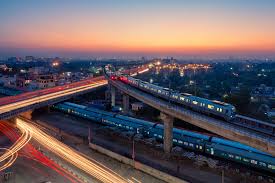Context-
In the past nine months, India has witnessed significant events capturing public attention: the inauguration of the new Parliament building and the Ram temple, both conducted by the Prime Minister. These events raise pertinent questions about the intersection of democracy, religion, and urban development. As the country embarks on massive infrastructure projects, particularly in religious cities like Ayodhya, it prompts a reflection on whether religion will become the driving force behind urbanization in India, superseding traditional pillars such as work, industry, and modernism.
The construction of the new Parliament building and the inauguration of the Ram temple signify a shift in the narrative surrounding urbanization in India. While cities have historically been viewed as engines of economic growth and centers of modernity, the emphasis on religious institutions in recent developments suggests a redefinition of urban priorities. This shift prompts a critical examination of the role of religion in shaping urban spaces and the implications for democratic governance.
Colonial vs. New Cities: Historical Perspectives
Historically, urban development in India has been shaped by colonial cities designed primarily for trade and administration. The legacy of British colonialism is evident in cities like Mumbai, Kolkata, and Delhi, which served as administrative centers and hubs for the transport of goods. These cities were characterized by grid-like layouts, distinct administrative zones, and infrastructure tailored to colonial interests.
Conversely, the emergence of new cities like Bhilai, Rourkela, and Chandigarh in the post-colonial era marked a departure from the colonial model. These cities were envisioned as centers of industrialization, designed to accommodate rural-to-urban migration and stimulate economic growth. Chandigarh, in particular, stands out as a symbol of modernist urban planning, with its grid pattern, green spaces, and functionalist architecture.
Emergence of Religious Cities: A New Urban Phenomenon
In recent times, a paradigm shift in urbanization is evident, challenging the conventional view of cities as centers of enlightenment and productivity. Instead, there's a resurgence of faith-driven urbanization, exemplified by investments in religious cities like Ayodhya. Even corporate entities are increasingly investing in such locations, signaling a broader trend towards aligning urban development with religious sentiments.
The transformation of Ayodhya into a focal point of urban development underscores the evolving dynamics of Indian cities. Once known primarily for its religious significance, Ayodhya is now the focus of ambitious infrastructure projects aimed at enhancing its appeal as a pilgrimage destination. The convergence of religion and urbanization in Ayodhya reflects a broader trend towards the commodification of spirituality and the monetization of religious heritage.
Investments and Urban Development: Random Modules or Strategic Planning?
While significant investments are being made in religious cities, questions arise regarding the rationale behind such expenditures. Projects like the Central Vista, the Sardar Patel statue, and the Ayodhya temple raise concerns about the government's priorities and its approach to urban development. Rather than adhering to a strategic plan for balanced regional development, the focus appears scattered and lacks coherence.
The concentration of resources in select urban projects raises questions about equity and inclusivity in urban planning. While iconic structures like the Central Vista may serve symbolic purposes, their exorbitant costs come under scrutiny amidst pressing socio-economic challenges. Moreover, the lack of transparency and public consultation in decision-making processes undermines the democratic principles that underpin urban governance.
State Intervention and Social Welfare: Revisiting the Role of Government
The role of the state in urban development becomes crucial in this context. In a democratic society, the accumulation of capital should ideally serve the social good, emphasizing investments in education, healthcare, and infrastructure. However, the current trend of channeling resources towards religious endeavors reflects a departure from this principle. This revivalism, characterized by centralized finances and the segregation of urban spaces along religious lines, necessitates a shift towards decentralization and democratization to ensure equal rights and opportunities for all citizens.
The prioritization of religious projects over social welfare initiatives raises fundamental questions about the role of the state in promoting inclusive urban development. While religious infrastructure may cater to the needs of specific communities, it does little to address the broader challenges of poverty, inequality, and access to basic services. Moreover, the politicization of religion in urban planning further exacerbates social tensions and undermines the secular fabric of Indian society.
Conclusion
In conclusion, the evolving urban landscape in India presents both opportunities and challenges. While the resurgence of religious cities signifies a cultural renaissance, it also raises concerns about the prioritization of resources and the exclusion of certain segments of society. As the country navigates this transition, it is imperative to strike a balance between tradition and modernity, ensuring that urban development remains inclusive, equitable, and aligned with the principles of social welfare. Only through thoughtful planning, strategic investments, and decentralized governance can India realize its vision of vibrant, sustainable, and harmonious cities for the future.
|
Probable Questions for UPSC Mains Exam-
|
Source- The Hindu







